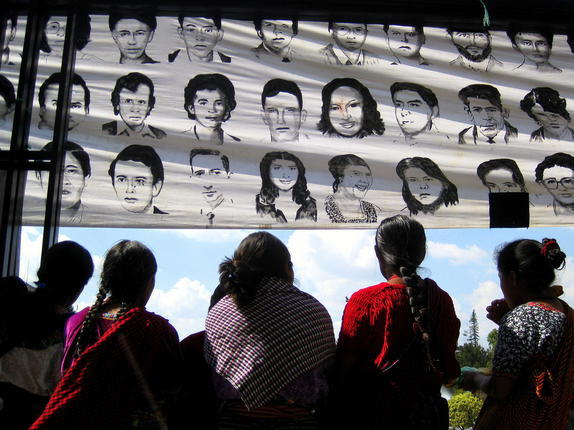Historical Background
“I know that President Rios Montt is a man of great personal integrity and commitment. His country is confronting a brutal challenge from guerrillas armed and supported by others outside Guatemala. I have assured the President that the United States is committed to support his efforts to restore democracy and to address the root causes of this violent insurgency. I know he wants to improve the quality of life for all Guatemalans and to promote social justice. My administration will do all it can to support his progressive efforts. “ – Ronald Reagan
“The eyes of the buried will close together on the day of justice, or they will never close.” – Miguel Angel Asturias, Guatemala’s Nobel Laureate for Literature
Ríos Montt and other high level military officials are facing trial on charges of genocide and crimes against humanity. Ríos Montt ruled Guatemala for only 17 months in 1982-83, but oversaw some of the worst atrocities of the internal conflict, including acts of genocide against the Ixil population in El Q’iché. In January 2012, Ríos Montt was officially charged and, after a year of delays, he and General Rodríguez Sánchez began trial March 19, 2013.
SILENT HOLOCAUST: 1978-1983
The conflict saw a major escalation with the election of General Fernando Romeo Lucas García in 1978. According to the Historical Clarification Commission, recorded cases of extrajudicial killings rose from 100 in 1978 to over 10,000 in 1981. A collection of statistical databases on the massacres is available here.
SCORCHED EARTH: 1982-1983
In 1982, General Efraín Ríos Montt replaced Lucas García as head of state. Ríos Montt enjoyed close ties with the Reagan administration and with Christian conservatives in the United States. His reign from March 1982 to August 1983 was the bloodiest period in Guatemala’s history. During that time, the Guatemalan government led a campaign to wipe out large portions of the country’s indigenous populations: an estimated 70,000 were killed or disappeared. In April 1982, Ríos Montt launched a ‘scorched earth’ operation against the Maya. The army and its paramilitary units – including ‘civilian patrols’ of forcibly conscripted local men – systematically attacked 626 villages. The inhabitants were raped, tortured and murdered. Over three hundred villages were completely razed. Buildings were demolished; crops and drinking water were fouled. A number of secret CIA cables from the period – declassified years later – documented the military’s sweeps through Mayan villages. In one cable describing a raid on a Quiché village, the author notes that the guerillas were often a phantom enemy, and that the army’s successes consisted of slaughtering civilians for their suspected rebel sympathies: “The well-documented belief by the army that the entire Ixil Indian population is pro-EGP has created a situation in which the army can be expected to give no quarter to combatants and non-combatants alike.” [6]
Civil war existed in Guatemala since the early 1960s due to inequalities existing in the economic and political life. In the 1970s, the Maya began participating in protests against the repressive government, demanding greater equality and inclusion of the Mayan language and culture. In 1980, the Guatemalan army instituted “Operation Sophia” which aimed at ending insurgent guerrilla warfare by destroying the civilian base in which they hid. This program specifically targeted the Mayan population, who were believed to be supporting the guerilla movement. Over the next three years, the army destroyed 626 villages, killed or “disappeared” more than 200,000 people and displaced an additional 1.5 million, while more than 150,000 were driven to seek refuge in Mexico. Forced disappearance policies included secretly arresting or abducting people, who were often killed and buried in unmarked graves. In addition, the government instituted a scorched earth policy, destroying and burning buildings and crops, slaughtering livestock, fouling water supplies and violating sacred places and cultural symbols. Many of these actions were undertaken by the army, specifically through special units known as the Kaibiles, in addition to private death squads, who often acted on the advice of the army. The U.S. government often supported the repressive regimes as a part of its anti-Communist policies during the Cold War. The violence faced by the Mayan people peaked between 1978 and 1986. Catholic priests and nuns also often faced violence as they supported the rights of the Mayan people.

